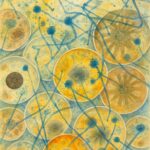Link to Pubmed [PMID] – 24903093
Arterioscler. Thromb. Vasc. Biol. 2014 Aug;34(8):1731-8
OBJECTIVE: Although the role of monocytes in the pathogenesis of atherosclerosis is well established, the persistent vascular inflammation remains largely unexplained. Recently, our group reported that stimulation of monocytes with various microbial products can induce a long-lasting proinflammatory phenotype via epigenetic reprogramming, a process termed trained immunity. We now hypothesize that oxidized low-density lipoprotein (oxLDL) also induces a long-lasting proinflammatory phenotype in monocytes, which accelerates atherosclerosis by proinflammatory cytokine production and foam cell formation.
APPROACH AND RESULTS: Isolated human monocytes were exposed for 24 hours to medium or oxLDL. After washing and resting for 6 days, the cells were exposed to toll-like receptor 2 and 4 agonists. Pre-exposure to oxLDL increased mRNA expression and protein formation on toll-like receptor 2 and 4 stimulation of several proatherogenic proteins, including interleukin-6, interleukin-18, interleukin-8, tumor necrosis factor-α, monocyte chemoattractant protein 1, and matrix metalloproteinase 2 and 9. In addition, foam cell formation was enhanced after oxLDL exposure, which was associated with an upregulation of scavenger receptors CD36 and scavenger receptor-A and downregulation of ATP-binding cassette transporters, ABCA1 and ABCG1. Chromatin immunoprecipitation performed 6 days after oxLDL stimulation demonstrated increased trimethylation of lysine 4 at histone 3 in promoter regions of tnfα, il-6, il-18, mcp-1, mmp2, mmp9, cd36, and sr-a. Finally, pretreatment of the monocytes with the histone methyltransferase inhibitor methylthioadenosine completely prevented the oxLDL-induced long-lasting proinflammatory phenotype.
CONCLUSIONS: Brief exposure of monocytes to a low concentration of oxLDL induces a long-lasting proatherogenic macrophage phenotype via epigenetic histone modifications, characterized by increased proinflammatory cytokine production and foam cell formation.

